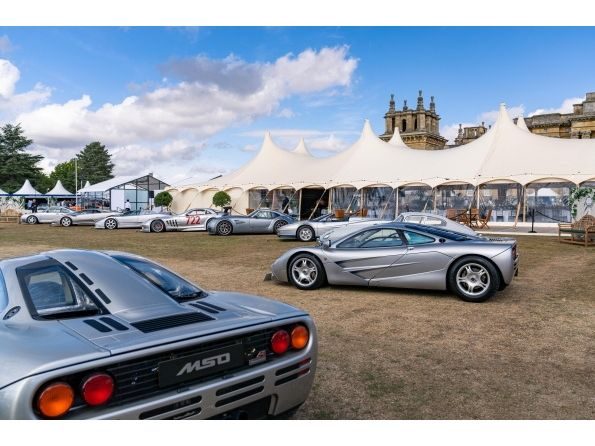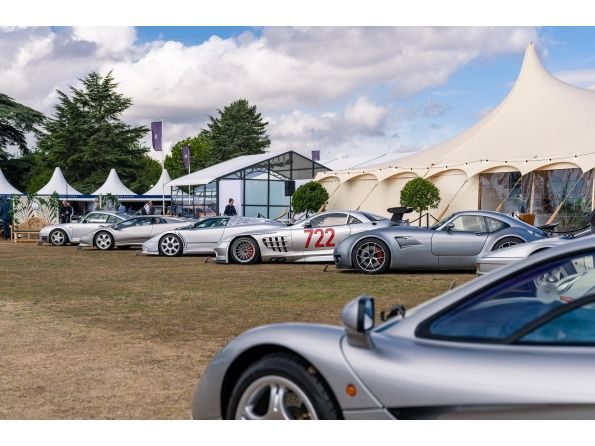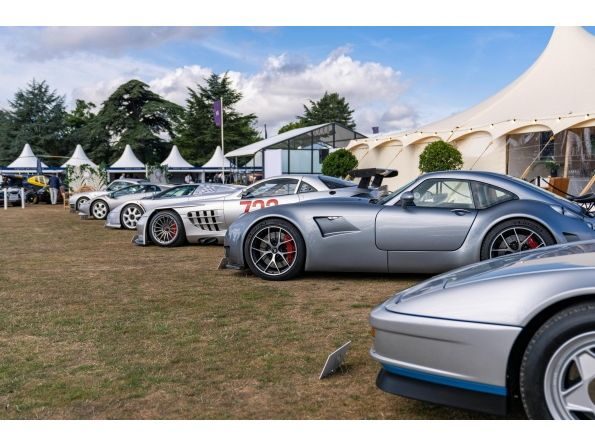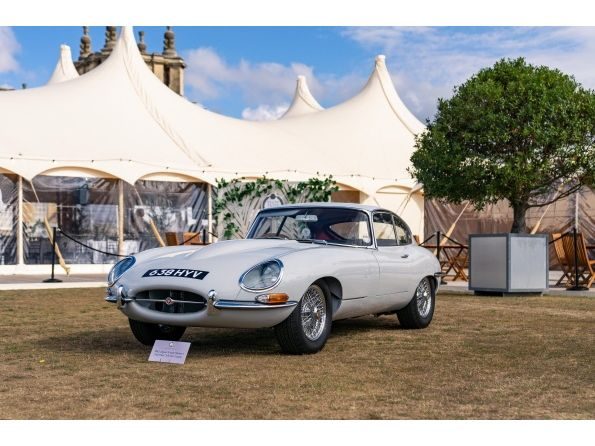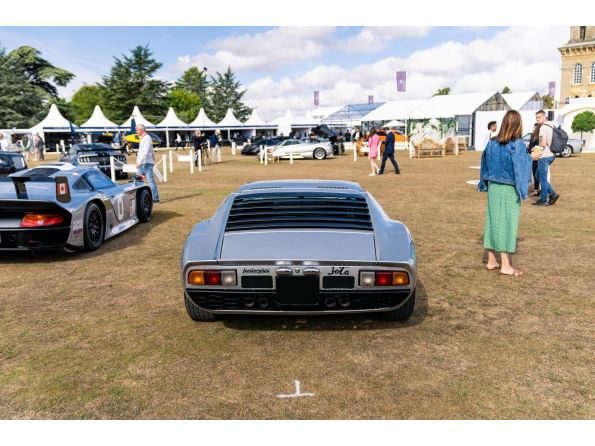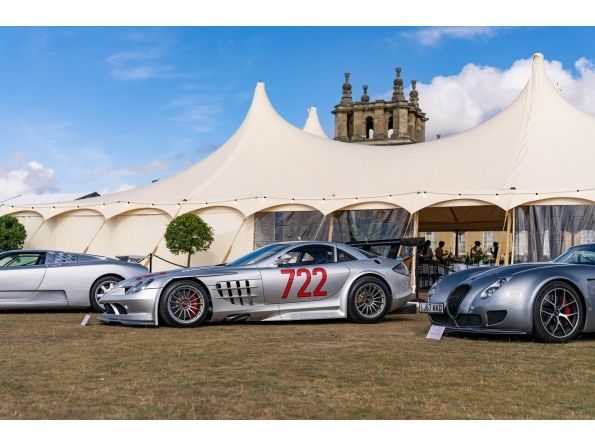Categories more
- Adventures (17)
- Arts / Collectables (15)
- Automotive (37)
- Aviation (11)
- Bath, Body, & Health (77)
- Children (6)
- Cigars / Spirits (32)
- Cuisine (16)
- Design/Architecture (22)
- Electronics (13)
- Entertainment (4)
- Event Planning (5)
- Fashion (46)
- Finance (9)
- Gifts / Misc (6)
- Home Decor (45)
- Jewelry (41)
- Pets (3)
- Philanthropy (1)
- Real Estate (16)
- Services (23)
- Sports / Golf (14)
- Vacation / Travel (60)
- Watches / Pens (15)
- Wines / Vines (24)
- Yachting / Boating (17)
Published
10/18/2022 by Salon PrivéTo celebrate Her Majesty The Queen’s 70th Jubilee, Salon Privé has curated ‘The Platinum Collection’, a display of stunning, as well as rare and historic platinum and silver-coloured motor cars of all ages.
Last year, ‘The Red Collection’ unveiled an exhibit of remarkable red-hued vehicles, to great acclaim from the world’s motoring press, on the lawns of Blenheim Palace for the opening day.
In this milestone year of Her Majesty The Queen’s reign, 16 iconic models from Aston Martin, Bugatti, Ferrari, Jaguar, Lamborghini, McLaren, Morgan, Porsche, Rolls-Royce and Wiesmann line up to form a truly unique display, a must-see at this year’s Salon Privé.
1961 JAGUAR E-TYPE SERIES 1 ‘FLAT FLOOR’ 3.8
Supplied new by Walter E. Strugess of Leicester on 27th September 1961 to Mr. D.J. Briggs of East Leake, this Jaguar E-type Series 1 Flat Floor 3.8 is a prime example of the first iteration of the iconic roadster.
It hails from the initial year of production, when around 1,500 ‘Flat Floor’ cars were built up to Christmas 1961. After this, the E-type’s floors were dished to provide more leg room and the twin bonnet latches moved to the inside of the car.
With its current owner since 2016, this matching-numbers Jaguar has seen intense restoration work, ensuring that no modern fittings have been used in order to retain the car’s “when it was new” ethos. All original components have been restored, including all of the electrical motors, gearbox and engine, and the Jaguar retains all its unique features, such as the door cappings and welded bonnet louvers that are the hallmark of these very first E-types.
2007 McLAREN MERCEDES SLR 722 GT PROTOTYPE
A project born from the famous collaboration between McLaren and Mercedes-Benz, to reflect the pair’s Formula One partnership, the 722 GT was the work of a team led by Gordon Murray. Pitched as a race car version of the road-going Mercedes-Benz SLR McLaren, the prototype on show at Salon Privé was built from a spare chassis and used parts from the McLaren F1, including wheels, wing, driver’s seat and pedal box.
It sufficiently impressed the McLaren board for it to receive a green-light, with a limited run of just 27 cars approved. The RML Group was tasked with delivering the racers, and the production version differed significantly from this prototype. Ultimately, the global recession of 2008 cut short the ‘McMerc’s’ run and just 12 cars were built in total. However, the prototype’s enduring appeal meant that McLaren Special Operations (MSO) was approached three years ago to convert 12 standard SLR Coupes as road-going homages to this unique vehicle, which were christened SLR HDK by MSO.
1997 PORSCHE GT1
A phenomenal and hugely significant car, the Porsche GT1 is a prototype racer designed to compete at the highest level. One of less than ten customer GT1 race cars in existence today, the example at Salon Privé is the Triple Canadian GT Championship winning car, and the only chassis to have left the factory in ‘EVO’ spec from new - all other examples were upgraded in period.
Retained by the original owner until 2013 and with only two owners since then, it’s been restored to perfection and converted to road-going specification by Lanzante. As such, it’s one of only two examples in road spec and legally registered for road use.
The car comes complete with a detailed chassis history report by noted Porsche historian and author John Starkey, plus all the items needed to return it to full track specification - should the owner wish to find out what this stunning machine is truly capable of.
2018 WIESMANN GT MF5 COUPÉ
The Wiesmann GT MF5 was first shown at the 2008 Geneva Motor Show. Founded in Germany in 1988, Wiesmann went on to become a highly successful and globally renowned brand.
Along with the Roadster model, the GT MF5 is exceptionally rare, with under 200 vehicles built in total. Production of the car took place in 2018 at Wiesmann’s ‘Gecko’ factory, a stunning state-of the-art facility in Dülmen, Germany, and it features a BMW twin-turbo engine with 555 bhp.
1997 McLAREN F1 #063
As custodians of the McLaren F1’s legacy, McLaren Special Operations (MSO) continues to develop and manufacture parts to ensure that every example remains an icon. McLaren F1 #063 is a prime example of MSO’s work, and its official certification programme.
Chassis 63 underwent a painstaking restoration over 18 months. The body and drivetrain were stripped from the chassis and, while the interior was then re-trimmed in Woking Grey, the body was repainted in the original Magnesium Silver. The car’s 6.1-litre normally- aspirated engine was also overhauled and rebuilt to ensure that it generated the same power it delivered when new.
The project required almost 3,000 hours of work, including final road and track testing. Once completed, chassis #063 was delivered back to its owner at the McLaren Technology Centre. The handover included its unique Certificate of Authenticity and a bespoke illustrated book documenting the history of the car, as well as a Genesis Speed Form. This 3D laser-scanned representation of the McLaren F1 distils the essence of the car into a scale model.
1997 McLAREN F1 #064
McLaren F1 chassis #064 was completed in 1997 and has travelled extensively over the last 25 years. It was sold new to a client in Sweden and delivered to Malmö but was soon spotted regularly on the streets of Stockholm. In 2006, it was transported to Germany and placed on sale, having been serviced at the end of the year. In 2007, it was sold to a buyer in Hong Kong, where it spent a couple of years, before travelling to a new custodian in Guernsey, in the Channel Islands.
This third owner kept the car for a couple of years and during his stewardship, the car joined events, including the 2012 McLaren F1 Owners’ Club Tour in Italy. More recently, it moved to the UK, with its current owner, and joined RofGo Collection, which houses some of the most desirable classic Gulf liveried cars in the world — including two Gulf Racing McLaren F1 GTR’s.
2010 LAMBORGHINI REVENTÓN ROADSTER
First seen at the 2007 Frankfurt Motor Show, the Lamborghini Reventón was at the time the most expensive Lamborghini road car ever produced. While it may share many of its mechanical components with the LP640 Murciélago, the Reventón features a completely reworked exterior and interior, both of which were designed to imitate an F-15 Eagle fighter jet. Just 20 Reventón Coupes were produced.
The Reventón utilises the 6.5-litre naturally aspirated V12 engine from the Murciélago, although improved induction liberates more power, bringing the total to a guaranteed 641bhp at 8000rpm. With a top speed of 211mph, the Lamborghini’s power is deployed through a 6-speed e-gear semi-automatic gearbox with the same AWD system found in the Murciélago.
In 2009, Lamborghini unveiled the Reventón Roadster, with a production run of just 15 units. The example at Salon Privé is a 2010 model, and is one of just three produced in RHD. It’s a UK supplied car, with just two owners from new, having covered just over 1,100 miles.
1962 JAGUAR E-TYPE COUPÉ SERIES 1 ‘FLAT FLOOR’ 3.8
Found around 35 years ago in pieces under a tarpaulin in a small village, this 1962 Jaguar E-type went to specialist West Riding Jaguar three years ago. Believed to have been owned by Don Haldenby, a mechanic who worked with Stirling Moss, the car is production number 161 and is a desirable 3.8 Flat Floor model. Receiving hundreds of man hours of loving restoration, the car is an absolutely stunning example of one the most iconic cars ever built.
1992 PORSCHE 959
The Porsche 959 was conceived as a Group B rally car, with homologation rules requiring at least 200 examples to be built over a 12-month period. Production had ceased in 1988 but a further eight cars, in Komfort specification, were built in 1992/93.
K1UFT is one of those last eight, and the last-but-one ever built. It was sold new in Germany, before being acquired by Anglo-Swiss collector, Anthony Maclean, who imported it to the UK and used it to commute in, travelling between the UK, Geneva and the south of France.
Several European owners enjoyed the car over three decades, with the car undergoing maintenance with Porsche Classic in Germany, but it was acquired by its current custodian in 2019. As before, the car is very much used and enjoyed - having covered over 9,300 miles since then. The 959’s extensive service history is fully documented, and it retains its original owner’s handbook, tool kit and workshop manual.
1986 LAMBORGHINI DIABLO SE30
Built to mark the famous company’s 30th anniversary, the Lamborghini Diablo SE30 is a unique iteration of the production, Diablo. With a host of weight-saving and performance-enhancing measures, it was the reserve of passionate customers and collectors who appreciated the finer qualities of this road-going GT racer.
This Diablo SE30 is number 64 of 150 and was first delivered in Austria in 1996, finished in the highly attractive colour combination of Titanium over Blue Alcantara. Remaining in the country for the next 24 years, it was impeccably maintained before being imported to the UK and registered. Upon arrival, it underwent a major service with Lamborghini Leicester, with the work costing over £8,000.
Having now covered just 25,012 miles, the car is accompanied by an extensive file documenting its history in both Austria and the UK, and is complete with the original book pack containing the owner’s manual, service booklet, original tool kit and all three sets of keys.
1993 BUGATTI EB110 SS
This EB110 is the first official production model of the Super Sport variant and is in original condition – complete with its Grigio Chiaro Metallic bodywork and Blu Scuro interior. An important car in the history of the Campogalliano Bugattis, EB110 Super Sport chassis SS01 was ordered by the Sultan of Brunei, who specifically requested one of the three first chassis numbers of the new supercar.
Unveiled at the 1992 Geneva International Motor Show, just six months after the introduction of the EB 110 GT, the more powerful Super Sport was also 150kg lighter than the GT, thanks to the use of carbon-fibre – for both exterior body panels and the interior.
The car wasn’t put into production until late 1993, when the development phase of the project was concluded. Completed just before the end of 1993 and delivered in Brunei at the beginning of 1994, it was fitted with a commemorative gold plate with the new owner’s initials detailed on various locations on the car.
1973 LAMBORGHINI P400 MIURA SVJ
The legend of the Lamborghini Miura is well documented, but the stunning example at this year’s Salon Privé has its own unique story.
Chassis 4860 was the fourth and last Miura SV ‘Jota’, or SVJ, officially built by Sant’Agata, before production finished in October 1973. It was a special order for Hubert Hahne: German Lamborghini importer, racing driver and friend of Ferruccio Lamborghini.
He personally supervised the build of his car, with unique details including a large fuel tank, allowing the car to cover 310 miles in one hit, as well as two wipers, no passenger-side mirror, upgraded headlamps, stiffer suspension and Borrani central wheel nuts, not spinners.
The car returned to Europe in 2018 for a conservative restoration. It was then placed under the intense scrutiny of the Lamborghini factory’s Polo Storico department, undergoing an exhaustive research and certification process, and was awarded a coveted Certificate of Historical Authenticity.
Exceptional in every detail, the ‘Hahne Jota’ was honoured in 2020 when exhibited at Rétromobile in Paris as part of Lamborgini’s Polo Storico display.
1960 ASTON MARTIN DB4
This superb Aston Martin DB4 chassis DB4/236/R was built in late 1959 and sold new to Mr. J. Tate in Oxted, through Aston Martin agents Brookland (H.W. Motors), on 21st January 1960. It is one of only 76 RHD DB4 Series 1 cars produced, and was finished in Cardinal Grey over Red Connolly interior - a combination which it wears to this day.
The first production car capable of 0-100 mph in under 30 seconds, Aston Martin claimed the DB4 reached the 100-mph mark in only 21 seconds, thanks to a straight six-cylinder 3.6-litre engine producing 240bhp. Accompanying the car is a fabulous history file which details the owners, and hours of restoration work it has received over the decades, along with many original MOT certificates, invoices and its original owner’s manual. The beautifully elegant open-headlight DB4 Series 1 is a true Aston Martin milestone, and the start of a hugely successful lineage of grand touring cars.
1963 MORGAN SLR
In the age of the Low Drag E-type and Daytona Cobra, a much less well-known aerodynamic version of a race car was prepared for competition, based on a Morgan +4. The Morgan SLR (Sprintzel, Lawrencetune Racing) was created in 1963 and just three cars were ever produced, plus one protype based on a Triumph TR4 chassis.
This particular SLR was the only one to race internationally and reportedly built just in time to race at Spa-Francorchamps. However, with no time remaining to paint the car before it departed the factory, the team paid some local schoolboys to polish the car just before the race. With aluminium bodywork handcrafted by Williams & Pritchard, the SLR was designed to capitalise on the class-winning standard Morgan +4, which won its class at Le Mans in 1962. Sadly, the SLR never made it to Le Mans due to the ill health of its engineer, Chris Lawrence, but this car has been actively campaigned as a race car ever since.
ROLLS-ROYCE PHANTOM II HANDLYE SPECIAL
The Handlye Special’s construction started 37 years ago, born from the owner’s realisation that acquiring a Vintage Grand Prix car was out of reach. Instead, he settled on building something unique. Taking roughly 20,000 hours to reach the road, it’s a homage to the achievements of Rolls-Royce on both land and in the air.
Its styling may be reminiscent of the P3 Alfa Romeo, but underneath the hand-formed alloy body, it’s all English. Starting with a standard Phantom II chassis, the custom drivetrain uses one of the marque’s most-celebrated engines, the mighty Merlin. In fact, the finished 27-litre unit is the result of harvesting components from two series 3 units, with other parts fabricated as needed.
The installation requires two gearboxes to correctly harness the power of the 900 bhp aero engine, including a specially designed step-up unit to raise the engine’s output rpm. Custom wheels were also needed, with specialist Crosthwaite and Gardiner manufacturing, and triple lacing alloy units into the existing Phantom wheel hubs.
FERRARI TESTAROSSA SPIDER
The only official Ferrari Testarossa Spider in the world was produced in 1986 for the then-Fiat chairman, Gianni Agnelli. An industrialist, who was affectionately known as: ‘The King of Italy’, Agnelli headed the conglomerate that included Ferrari, Maserati, Alfa Romeo and Lancia.
A unique version of an iconic car, the chassis and running gear were developed at Ferrari, but the specially designed coachwork, with lowered windscreen and specially manufactured wing mirror supports, was the work of the Director of Design at Pininfarina, Leonardo Fioravanti. Fioravanti later became a director of Ferrari, but he was the man responsible for the design of the Ferrari Daytona, 288 GTO and F40.
An accident earlier in his life meant Agnelli struggled with a leg injury, so Ferrari also fitted the Testarossa Spider with a Valeo gearbox, allowing it to be driven normally or with a clutch-less gear change. The car has only had three owners in its 46 years and has covered less than 14,000 miles in that time.
Tickets for Salon Privé at Blenheim Palace are on sale now www.salonpriveconcours.com/buy-tickets/














